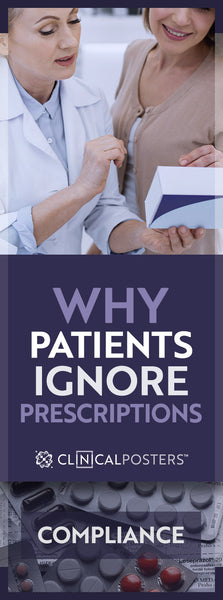Take one half tablet 3x per day with meals, increasing by half each week until reaching a maximum of 3 tablets 3x per day.
« Login For Audio »
Are You Confused?
Did you get a new prescription from your doctor? If so, there is a fifty percent chance you will not adhere to label directions. Either instructions are too complicated, the drugs are too expensive, you do not like the way the medicine makes you feel, or a lack of physician follow up makes you question whether they are effective and still required.
Taking just the right amount of medication is rare among patients. Too much or too little is common. This frustrates diligent doctors trying to document effectiveness. It also wastes drugs and diminishes health. Through the eyes of patients, much of the prescription compliance problem falls on the shoulders of physicians. Most doctors reverse the blame. Likely, both are at fault to some degree.
Common Medication Direction Abbreviations
I have respect for the years of selfless training that physicians undertake. Many are overworked, yet they tirelessly care for patients streaming into waiting rooms day after day. Each comes with a unique problem and a different history. Yet, inside of 10 minutes, a doctor usually offers a prescription based on past experience and laws of averages—perhaps with the help of a computer. Following up with any adverse side effects is left to the patient.
Past situations shape compliance. I hope my experiences are unique, but would love honest feedback on how common they may be:
Who’s to Blame?
Preliminary diagnosis: Raynaud’s Phenomenon (unconfirmed)
In my late 20s, a primary-care doctor over-prescribed medications—usually by giving out samples. This kept costs down but circumvented pharmacy alerts. By addressing each symptom with 3–5 prescriptions, he had me on over 20 different meds at once. Let me take you through the rationale:
Explaining that cold hands are due to vasoconstriction, there is a need for vasodilators like atenolol, nifedipine, nitroglycerin and high doses of vitamin E. However, this leads to hypotension, migraines, stomach irritation and shock. Responding to this with triptans, sucralfate, famotidine, alprazolam, metoclopramide and Mylanta leads to more drug interactions for which, yes, more drugs, emergency room visits, and hospital admissions are necessary.
After escalating to cardiologist, neurologist, gastroenterologist and oncologist referral consultations, the latter broke the unspoken rule of not contradicting another doctor and recommended that I replace all the medications with a multivitamin. In addition to learning not to take everything prescribed, I discovered two severe drug allergies and—thanks to emergency personnel—the value of Benadryl.

Preliminary diagnosis: Benign paroxysmal positional vertigo (incorrect)
When reporting to an otolaryngologist a drug reaction to prescribed medication, he became visibly angry since I stopped taking them within the 2-week period between appointments. Scolding me to respect him as the authority and refusing to prescribe an alternative led this office to have one less patient.
Despite voicing apprehension years later, the same drug (now available without prescription) was recommended by a physician’s assistant. The rare reaction of rapid heartbeat and tightness in the chest, occurred again. (Kudos if you can correctly identify the popular drug from these clues.)
After reliving the hour-long trauma in supine position, I more emphatically refuse this prescription that has been added to my electronic medical record and the paper medical directive in my wallet.
Preliminary diagnosis: Confluent and reticulated papillomatosis (incorrect)
Following an unsutured punch biopsy with nonspecific results, a dermatologist appeared to type something like “chest spots” into his exam-room diagnosis database and read off the first thing that popped up—a condition affecting most of the torso—not an area the size of a nickel. For this an ineffective $500 ointment was prescribed. The correct cream costs less than 20 bucks.
Miscellaneous allergy-related diagnoses
Three doctors have asked me what drug do I want to try—as if the patient should know in advance. At least four specialists evidently prescribe the same medication to all their patients. One even added, ”More than half of them respond well.” Well good for them, but I am uncomfortable with suicide as a side effect.
A few black-box warning prescriptions and those with ingredients to which I have had prior allergic reactions have been discontinued after department heads discovered the error. I was simply told the prescribers no longer work for the company and to stop taking the drugs immediately. While looking up side effects for one sample prescription handed to me by a well-meaning doctor, I discovered it had been recalled. Crisis averted before taking any.

Sample of various pharmaceutical drugs (not prescribed to the author).
Road to Compliance
Mistakes can happen with anyone. But as an apparent lightening rod for botched prescriptions, adverse reactions must be my primary reason for non-compliance to varying degrees. I am also apprehensive about taking drugs indefinitely—especially when there is no apparent benefit. In my mind, ideal circumstances for prescriptions with compliance looks something like this:
- Evaluate thorough patient history.
- Accurately diagnosis condition.
- Provide easy-to-follow instructions.
- Determine if patient can afford prescription.
- Identify clear path to a favorable outcome.
- Short interval between followup.
- Adjust according to patient reaction.
My current physicians are asked to prescribe as low dose as possible to gauge reaction before increasing dosage. Lists of side effects and contraindications are studied prior to ingestion. This helps me to identify symptoms that should be alerted to my doctor immediately versus the next office visit.
Recognize that for some ailments, there is no medical cure. Prescribing medications without likely recovery is frustrating and expensive. The remedy may require addressing a change in diet or physical fitness. For chronic pain, patient comfort is most desirable.
Online services and apps now allow prescription price comparisons and coupons. This may not always be helpful when the doctor’s office requests, before you leave, the name of the pharmacy to send the prescription electronically.
Patients with several prescriptions might benefit from dividing them within daily pill containers. In addition to vitamins, I currently take one prescription at bedtime and another as needed. They do not cure all that ails me but they are affordable, have predictable side effects, and the steps for compliance are simple to follow.
Resilience despite inaccurate prescriptions eventually led to subcontracting as a graphics consultant for 17 years with scientists in the claim substantiation department of a skin-care company that was eventually acquired by a major pharmaceutical company. These experiences fuel the content within health articles at ClinicalPosters.com.

References
- Patient Medication Adherence: Measures in Daily Practice. nih.gov
- Black Box Warnings. lynnwebstermd.com
- What is GoodRx? How does it work? goodrx.com






